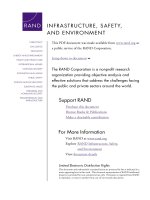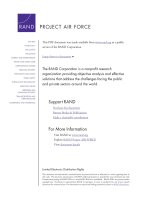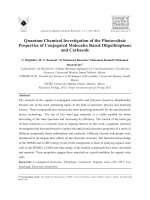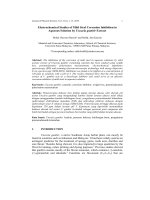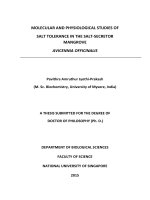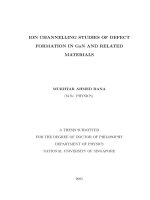Synthesis, inhibition effects and quantum chemical studies of a novel coumarin derivative on the corrosion of mild steel in a hydrochloric acid solution
Bạn đang xem bản rút gọn của tài liệu. Xem và tải ngay bản đầy đủ của tài liệu tại đây (2.74 MB, 9 trang )
Al‑Azawi et al. Chemistry Central Journal (2016) 10:23
DOI 10.1186/s13065-016-0170-3
Open Access
SHORT REPORT
Synthesis, inhibition effects
and quantum chemical studies of a novel
coumarin derivative on the corrosion of mild
steel in a hydrochloric acid solution
Khalida F. Al‑Azawi1, Shaimaa B. Al‑Baghdadi1, Ayad Z. Mohamed1, Ahmed A. Al‑Amiery1,2*, Talib K. Abed1,
Salam A. Mohammed3, Abdul Amir H. Kadhum2 and Abu Bakar Mohamad2
Abstract
Background: The acid corrosion inhibition process of mild steel in 1 M HCl by 4-[(2-amino-1, 3, 4-thiadiazol-5-yl)
methoxy]coumarin (ATC), has been investigated using weight loss technique and scanning electron microscopy
(SEM). ATC was synthesized, and its chemical structure was elucidated and confirmed using spectroscopic techniques
(infrared and nuclear magnetic resonance spectroscopy).
Findings: The results indicated that inhibition efficiencies were enhanced with an increase in concentration of
inhibitor and decreased with a rise in temperature. The adsorption equilibrium constant (K) and standard free energy
of adsorption (ΔGads) were calculated. Quantum chemical parameters such as highest occupied molecular orbital
energy, lowest unoccupied molecular orbital energy (EHOMO and ELUMO, respectively) and dipole moment (μ) were
calculated and discussed. The results showed that the corrosion inhibition efficiency increased with an increase in
both the EHOMO and μ values but with a decrease in the ELUMO value.
Conclusions: Our research show that the synthesized macromolecule represents an excellent inhibitor for materials
in acidic solutions. The efficiency of this macromolecule had maximum inhibition efficiency up to 96 % at 0.5 mM and
diminishes with a higher temperature degree, which is revealing of chemical adsorption. An inhibitor molecule were
absorbed by metal surface and follow Langmuir isotherms low and establishes an efficient macromolecule inhibitor
having excellent inhibitive properties due to entity of S (sulfur) atom, N (nitrogen) atom and O (oxygen) atom.
Keywords: (thiadiazol-5-yl)methoxy)coumarin, Corrosion inhibitor, Isotherm, Weight loss
Background
It is very important to use corrosion inhibitors to prevent metal dissolution and minimize acid consumption
[1–4]. The majority of well-known acid inhibitors are
organic compounds that contain nitrogen, sulfur and
oxygen atoms. The inhibitory action exercised by organic
compounds on the dissolution of metallic species is normally related to adsorption interactions between the
inhibitors and the metal surface. The planarity (p) and
*Correspondence:
1
University of Technology (UOT), Baghdad 10001, Iraq
Full list of author information is available at the end of the article
lone pairs of electrons present on N, O and S atoms are
important structural features that control the adsorption
of these molecules onto the surface of the metal [5–7].
The effective and efficient corrosion inhibitors are those
compounds that have π-bonds, contain hetero-atoms
such as sulfur, nitrogen, oxygen and phosphorous and
allow the adsorption of compounds on the metal surface
[8–11]. The organic inhibitors decrease the corrosion
rate by adsorbing on the metal surface and blocking the
active sites by displacing water molecules, leading to the
formation of a compact barrier film on the metal surface. Coumarins exhibit pharmacological activities, such
as anticancer, anti-inflammatory [12], anti-influenza,
© 2016 Al-Azawi et al. This article is distributed under the terms of the Creative Commons Attribution 4.0 International License
( which permits unrestricted use, distribution, and reproduction in any medium,
provided you give appropriate credit to the original author(s) and the source, provide a link to the Creative Commons license,
and indicate if changes were made. The Creative Commons Public Domain Dedication waiver ( />publicdomain/zero/1.0/) applies to the data made available in this article, unless otherwise stated.
Al‑Azawi et al. Chemistry Central Journal (2016) 10:23
antituberculosis [13], anti-HIV, antiviral, antialzheimer
and antimicrobial activities [14]. Nowadays researchers go
for coumarins to used as corrosion inhibitors due to the
electronic structure, planarity, lone pairs of electrons present on oxygen and stability [15–17]. The successful control of corrosion develops the life of mechanical hardware.
Nowadays corrosion inhibitors have more significant, due
to their usage in industries. Organic inhibitors considered
as eco-friendly much more than inorganic one. Organic
inhibitors decreasing the corrosion rate by adsorbing onto
the surface of the metal through the active sites namely
phosphorus, sulfur, oxygen, nitrogen atoms or pi-bonds
[18]. Recently the quantum chemical computations based
on density function theory (DFT) become powerful investigation theoretical tool for researchers to investigate the
ability of organic molecules as corrosion inhibitions. This
tool offers a glance at physical insights on corrosion inhibition mechanisms [19]. In continuation of previous work
[20–27], we focus herein on the design our approach to
increase the inhibitive properties based on conjugated
system and electron density, in addition to applied the
theoretical studies to associate the inhibitive properties
with electronic structures. Initially we were starting from
4-hydroxycoumarin as starting material for the synthesis
of 4-[(2-amino-1, 3, 4-thiadiazol-5-yl)methoxy]coumarin
(ATC) contain 1, 3, 4-thiadiazol moiety.
Methods
Chemistry
The chemicals utilized were supplied by Sigma-Aldrich
and the purity checked by TLC (thin layer chromatography). Infrared spectra were obtained on a Thermo
Scientific, NICOLET 6700 FTIR spectrometer. Nuclear
magnetic resonance spectra were obtained on a JEOL
JNM-ECP 400. Elemental microanalysis, was carried out
using a model 5500-Carlo Erba C.H.N elemental analyzer.
Synthesis of corrosion inhibitor “4‑[(2‑amino‑1, 3,
4‑thiadiazol‑5‑yl)methoxy]coumarin (ATC)”
This compound was synthesized in good yield according
to the previously described procedures [28, 29]. Phosphorus oxychloride (20 ml) was added to 2-(2-oxo-2Hchromen-4-yloxy) acetic acid (0.05 mol) and the mixture
was stirred for I h at room temperature. Thiosemicarbazide (4.56 g, 0.05 mol) was added and the mixture was
heated and reflux for 5 h. On cooling, the mixture was
poured on to ice. After 4 h stir for 15 min to decompose
the excess phosphorusoxychloride, then heated under
reflux for 30 min, cooling, the mixture was neutralized
by 5 % potassium hydroxide, the precipitated was filtered, washed with water, dried and crystallized. Recrystallization from dichloromethane yields 55 %, m.p. 99 °C;
1H-NMR (CDCl3): δ 5.62 (s, 1H, –C=C–H), δ 4.91 and
Page 2 of 9
δ 5.33 (d, 2H, t, 2H, for OCH2), δ 7.23–7.87 (m, 1H, C–H
aromatic ring), δ5.21 (s, NH2); IR: 3314.5 and 3375.1 cm−1
(s, H, amine), 291.2 (C–H alkane); 3079.1 (C–H aromatic),1752.3 cm−1 (C=O, lactone), 1591.1 cm−1(C=N,
imine), 1635.3 cm−1 (C=C aromatic); Anal. Calcd. for
C12H9N3O3S: C 52.36 %, H 3.30 %, N 15.26 %. Experimentally: C 51.64 % H 2.92 % and N 14.94 %s.
Gravimetric information
Specimens
Mild steel specimens utilized throughout our work were
supplied from “Metal-Samples-Company” (St. Marys,
PA, United States). The weight composition percentages of the MS were: Iron, 99.21; Carbon, 0.21; Silicon,
0.38; Phosphorous, 0.09; S, 0.05; Manganese, 0.05; and
Alaminuim, 0.01. The specimens were cleaned using the
chemical cleaning procedures described in ASTM G1-03
test method [30]. All experiments were done in aerated
and non stirred hydrochloric acid mediums contain various concentrations of (ATC).
Weight loss techniques
The MS specimens were suspended separately in duplicate in 200 mL of the test solution, with and without
various concentrations (0.0, 0.05, 0.1, 0.15, 0.20, 0.25 and
0.50 mM) of the ATC. After 1, 2, 3, 4, 5, 10 and 24 h., of
immersion time, at temperatures, namely, 303, 313, 323
and 333 K. The specimens were taken out, washed, dried,
and weighed accurately. The inhibition efficiencies (% IE)
values were calculated using of in Eq. 1.
IE(%) =
wo − w1
× 100
wo
(1)
where, wo is the weight loss value in the absence of ATC,
and w1 is the weight loss values in the presence of ATC.
The corrosion rates (CR) were determined by using
Eq. (2) [31, 32]
CR =
87.6w
atρ
(2)
Quantum chemical calculations
The molecular optimization was carried out using the
density function theory (DFT)/B3LYP with basis set
6-31G. Quantum chemical calculations such as E HOMO
(highest occupied molecular orbital energy), E LUMO (lowest unoccupied molecular orbital energy) and μ (dipole
moment) were calculated and discussed.
Results and discussion
Weight loss method
Effect of concentration
Corrosion rate inhibition efficiencies were calculated for
various concentrations of ATC for the duration 1, 2, 3, 4,
Al‑Azawi et al. Chemistry Central Journal (2016) 10:23
Page 3 of 9
Fig. 1 Influences of concentrations vs time for ATC on corrosion rate at 303 K
Fig. 2 Influences of concentrations vs time for ATC on corrosion efficiencies at 303 K
5, 10 and 24 h, at 303 K are shown in Figs. 1 and 2. ATC
obviously diminutive the corrosion in acidic solutions for
MS. The IE (%) raise with the increment of concentration
of ATC and become the maximum at the highest concentration of ATC. The increment of inhibition efficiencies
with the concentration imply the increase in the ATC as
a potent of protection efficiency. This might be due to
the adsorption of inhibitor molecule on the metal surface as a protective layer giving high inhibition efficiency.
Moreover, ATC has different active sites due to N, O and
S atoms that make complexation with the metal easy and
that would increase its adsorption on the metal surface.
Effect of temperature
A differentiation of the inhibition efficiencies of ATC on
mild steel in acidic medium with and without of different
concentrations of ATC at various temperatures (303, 313,
323 and 333 K) indicates that corrosion efficiency rise with
increasing of concentration and reduced with temperature rise (Fig. 3). Generally when the organic compounds
adsorbed, the heat of adsorption will be negative, and this
mean the process was an exothermic, so this is why the
inhibitor efficiencies reduces when the temperature rise.
Scanning electron microscopy, SEM
As shown in Fig. 4, metal surface, that was originally
smooth and neat, crumbled from corrosion and turn into
rough surface and was extremely damaged by acidic solution. From Fig. 5, the healed surface of the metal was not
suffering from remarkable corrosion. The synthesized
macromolecule that supply protection to the surface of
the metal from the acid.
Al‑Azawi et al. Chemistry Central Journal (2016) 10:23
Page 4 of 9
Fig. 3 Influences of concentrations vs temperatures for ATC on corrosion efficiencies at fixed time
Fig. 4 The SEM micrograph for MS in in acidic medium in absence
of ATC
Fig. 5 The SEM micrographs, for MS in acidic medium with 0.5 mM of
the corrosion inhibitor at 30 °C for 5 h as immersion time in presence
of ATC
Adsorption isotherm and mechanism of corrosion
and inhibition
Generally, IE of corrosion inhibitors depend on the
adsorption coefficient of MS. The stabilization of the
adsorbed inhibitor molecules differ according to the type
of adsorption is chemical or physical or both. Turn out
it is needful to explore the interaction between the metal
and the inhibitor through adsorption isotherms [33].
The action of corrosion inhibitor over MS surface can
be interpreted according to adsorption isotherm. Generally adsorption be based on the morphology nature.
The mechanism of adsorption of organic molecules on
MS surface can be clarified by means of the investigation
of adsorption isotherm and adsorptive conduct of the
inhibitor. Langmuir, Frumkin, Temkin and Freundluich
isotherms were the most considerably utilized adsorption isotherm [34]. The corrosion inhibitors of natural
and synthetic organic inhibitors on MS in acidic medium
can be showed by a molecular adsorption technique. The
process of adsorption was impacted by the structures and
nature of the molecules in addition to the nature of the
surface/charged metals and the types of media used [35,
36]. Surface coverage (θ) for the various concentrations
of the tested inhibitor was utilized to elucidate the preferable adsorption isotherm to determine the adsorption
process. To estimated θ, it was proposed [37] that the
inhibition efficiency is due fundamentally to the blocking
effect of the adsorbed molecules or ions and so, Eq. (3)
will be applied.
θ=
IE%
100
(3)
The plot of Cθinh vs concentration of inhibitor (Cinh) produce a straight line with an approximately unit slope,
indicating that the inhibitor under study obeys the Langmuir adsorption isotherm [38], as in the Eq. (4).
1
Cinh
=
+ Cinh
θ
Kads
(4)
Al‑Azawi et al. Chemistry Central Journal (2016) 10:23
Page 5 of 9
Kads is the adsorption constant obtained from the intercept of the straight line.
Equation 5 give the association of the intercept of the
◦
straight line Kads with the standard free energy Gads
◦
Gads = −RTln[55.5Kads ]
(5)
whereas R is the universal gas constant, the number 55.5
is the molar concentration of water in solution and T is
the absolute temperature.
◦
◦
From Fig. 6 we can calculate Kads and Gads. Gads.
◦
From Fig. 6 Gads was calculated and it was −31.51 kJ/
◦
mol. The negatively charge for Gadselucidate the natural
adsorption of the ATC on the MS surface and the vigorous interaction through the ATC and MS surface. Gen◦
erally, if Gads is nearly −20 kJ/mol then it appropriate
◦
with physical adsorption, while if Gads nearly −40 kJ/
mol then it is chemical adsorption occurring with the
sharing of electrons from molecules of the inhibitor to
◦
the MS surface. In our work the Gads is around −40 kJ/
mol and demonstrate mechanism of adsorption of ATC
by means of chemical adsorption [39]. In hydrochloric
acid solution the following mechanism is proposed for
the corrosion of mild steel [40]. The anodic dissolution
mechanism of mild steel is
Fe + Cl− ↔ (FeCl− )ads
(FeCl− )ads ↔ (FeCl+ )ads + e−
(FeCl+ )ads ↔ Fe++ + Cl−
The cathodic hydrogen evolution mechanism is
Fe + H+ ↔ (FeH+ )ads
(FeH+ )ads + e− (FeH)ads
Fig. 6 Linear equation
(FeH+ )ads + H+ + e− → Fe + H2
Generally, the corrosion inhibition mechanism in an
acid medium is adsorption of the inhibitor on the metal
surface. The process of adsorption is influenced by different factors like the nature and charge of the metal, the
chemical structure of the organic inhibitor and the type
of aggressive electrolyte [41–43].
Suggested mechanisms of actions of coumarin as inhibitor
Chemically the inhibitor is adsorbed on the metal surface
and forms a protective thin film or chemical bonds form
by reaction between the inhibitor and metal. The adsorption mechanism of organic inhibitors can proceed via one
of these routes. 1st, charged molecules and metal attract
electrostatically. 2nd, the interaction between unpaired
electrons and the metal surface. 3rd, interaction between
π-electrons and the metal surface. Organic inhibitors
protect the metal surface by blocking cathodic or anodic
reactions or both and forming insoluble complexes. The
inhibition efficiency of our corrosion inhibitor against
the corrosion of mild steel in 1 M hydrochloric acid can
be explained according to the number of adsorption sites,
charge density, molecular size, mode of interaction with
the metal surface and ability of formation of metallic
insoluble complex. The π electrons for the double bonds
and free electrons on the oxygen and nitrogen atoms
form chemical bonds with the metal surface as shown in
Fig. 7.
Quantum chemical calculations
The structural nature of the organic corrosion inhibitor
and inhibition mechanism can be described by density
Al‑Azawi et al. Chemistry Central Journal (2016) 10:23
Page 6 of 9
Table 1 Calculated quantum chemical properties for the
most stable conformation of (ATC)
Function
EHOMO
ELUMO
EHOMO–ELUMO
f−max
Fig. 7 The suggested mechanism of action of the ATC as corrosion
inhibitor
functional theory (DFT). This technique has been found
to be successful in providing insights into the chemical
reactivity and selectivity in terms of global parameters
such as electro-negativity (v), hardness (g) and softness
(S), and local softness (sđ~r Þ) [44, 45]. The design of the
(ATC), for use as a corrosion inhibitor was based on several factors. First, the molecule contains oxygen, nitrogen
and sulfur atoms as active centers. Second, (ATC), can
be easily synthesized and characterized. Third, planarity and finaly the resonance structure of (ATC). Excellent corrosion inhibitors are usually organic compounds
that not only offer electrons to unoccupied orbitals of
the metal but also accept free electrons from the metal
[46]. Quantum chemical theoretically calculations were
used to investigated the interactions between metal
and inhibitor [47]. Highest occupied molecular orbital
(HOMO), lowest unoccupied molecular orbital (LUMO),
and Fukui functions as well as the total electron density of (ATC), are presented in Fig. 7. The blue and red
iso-surfaces depict the electron density difference; the
blue regions show electron accumulation while the red
regions show electron loss. Quantum parameters such as
EHOMO, EHOMO and dipole moment are provided in
Table 1. The HOMO regions for the molecule, which are
the sites at which electrophiles attack and represent the
active centers with the utmost ability to interact with the
metal surface atoms, has contributions from carbonyl,
methanimine and amine. On the other hand, the LUMO
orbital can accept electrons from the metal using antibonding orbitals to form feedback bonds are saturated
around the coumarin ring [48]. Correspondingly, a high
value of the HOMO energy (EHOMO) indicates the tendency of a molecule to donate electrons to an appropriate
acceptor molecule with low energy or an empty electron
orbital, whereas the energy of the LUMO characterizes
Function values
7.909 eV
3.901 eV
−4.008 eV
0.164
f+max
0.093
Dipole Moment
4.959
the susceptibility of molecule toward nucleophilic attack
[49]. Low values of the energy of the gap ΔE = ELUMO−
EHOMO implies that the energy to remove an electron
from the last occupied orbital will be minimized, corresponding to improved inhibition efficiencies [50].
EHOMO value (Table 1) do not vary very significantly for
(ATC), which means that any observed differences in the
adsorption strengths would result from molecular size
parameters rather than electronic structure parameters.
The seemingly high value of ΔE is in accordance with the
nonspecific nature of the interactions of the molecule
with the metal surface. A relationship between the corrosion inhibition efficiency of the (ATC), with the orbital
energies of the HOMO (EHOMO) and LUMO (ELUMO)
as well as the dipole moment (μ) is shown in Table 1. As
is clearly observed, the inhibition efficiency increases
with an increase in EHOMO values along with a decrease
in ELUMO values. The increasing values of EHOMO
indicate a higher tendency for the donation of electrons
to the molecule with an unoccupied orbital. Increasing values of EHOMO thus facilitate the adsorption of
the inhibitor. Thus, enhancing the transport process
through the adsorbed layer would improve the inhibition effectiveness of the inhibitor. This finding can be
explained as follows. ELUMO indicates the ability of the
molecule to accept electrons; therefore, a lower value of
ELUMO more clearly indicates that the molecule would
accept electrons [51]. The direction of a corrosion inhibition process can be predicted according to the dipole
moment (μ). Dipole moment is the measure of polarity
in a bond and is related to the distribution of electrons
in a molecule. In spite of the fact that literature is conflicting on the utilization of μ as an indicator of the direction of a corrosion inhibition reaction, it is for the most
part concurred that the adsorption of polar compounds
having high dipole moments on the metal surface ought
to prompt better inhibition efficiency. The data obtained
from the present study indicate that the (ATC), inhibitor has the value of μ = 4.959 and highest inhibition
efficiency (96.0 %). The dipole moment is another indicator of the electronic distribution within a molecule.
Al‑Azawi et al. Chemistry Central Journal (2016) 10:23
A few researchers express that the inhibition efficiency
increments with increasing values of the dipole moment,
which relies on upon the sort and nature of molecules
considered. However, there is a lack of agreement in the
literature on the correlation between μ and IE %, as in
some cases no significant relationship between these
values has been identified [52, 53]. The electron density
(charge distribution) is saturated all around molecule;
hence we should expect flat-lying adsorption orientations [48]. The local reactivity of molecule was analyzed
by means of the Fukui indices (FI) to assess reactive
regions in terms of nucleophilic (f+) and electrophilic
(f−) behavior. Figure 8d shows that the f− functions of
molecule correspond with the HOMO locations, indicating the sites through which the molecule could be
adsorbed on the metal surface, whereas f+ (Fig. 8e) correspond with the LUMO locations, showing sites through
which the molecule could interact with the nonbonding
electrons in the metal. High f− values are associated with
the nitrogen atoms of thiadiazole ring and oxygen of the
pyrone ring, in addition to oxygen atom of the bridge.
Mulliken charge
The Mulliken charge distribution of (ATC) is presented in Table 2. Atom can be easily donating its
electron to the empty orbital of the metal if the Mulliken charges of the adsorbed center become more
Page 7 of 9
negative [54]. It could be readily observed that nitrogen, oxygen, sulfur and some carbon atoms have high
charge densities. The regions of highest electron density are generally the sites to which electrophiles can
attach [54, 55]. Therefore, N, O, S and some C atoms
are the active centers, which have the strongest ability
to bond to the metal surface. Conversely, some carbon
atoms carry positive charges, which are often sites
where nucleophiles can attach. Therefore, (ATC) can
also accept electrons from Fe through these atoms.
It has been reported that excellent corrosion inhibitors can not only offer electrons to unoccupied orbitals of the metal but also accept free electrons from
the metal [56]. According to the description of frontier orbital theory, HOMO (Fig. 9) is often associated
with the electron donating ability of an inhibitor molecule. The molecules have tendency to donate electrons to a metal with empty molecule orbital if they
have high EHOMO values. ELUMO, conversely, indicates the ability of the molecule to accept electrons
[57]. Acceptance of electrons from a metal surface is
easier when the molecule has lower value of ELUMO.
The gap between the LUMO and HOMO energy levels
of inhibitor molecules is another important parameter. Low absolute values of the energy band gap
(E = ELUMO−EHOMO) mean good inhibition efficiency [58].
Fig. 8 Electronic properties of (a) 3d-structure of ATC; (b) HOMO orbital; (c) LUMO orbital; (d) total electron density; (e) Fukui (f−) function; f Fukui
(f+) function
Al‑Azawi et al. Chemistry Central Journal (2016) 10:23
Page 8 of 9
Table 2 Charges (Mulliken charges) for the ATC
Atom
Charge
Atom
Charge
Atom
Charge
Atom
Charge
O(1)
−0.2442
C(8)
−0.1049
C(15)
−0.0994
−0.3089
C(10)
−0.0871
N(17)
C(2)
O(3)
C(4)
C(5)
C(6)
C(7)
0.3942
C(9)
−0.2699
C(11)
0.2471
O(12)
−0.1560
C(13)
0.0340
S(14)
−0.0009
N(16)
0.1634
C(18)
−0.2770
N(19)
0.2660
H(20)
0.3809
H(21)
H(22)
0.0689
−0.1540
H(23)
0.0680
−0.0458
H(24)
0.0876
−0.2814
H(25)
0.0382
−0.2055
H(26)
0.0115
0.0977
H(27)
0.1429
0.0738
H(28)
0.1606
macromolecules obviously expose their function in the
protection of MS in 1 M HCl.
Authors’ contributions
AAA the principle investigator and wrote the main manuscript text. KFA and
SBA evaluated the corrosion inhibitor with surface characterization, AZM, SAM
and TKA were synthesis the inhibitor and prepared Figures while ABM and
AHK were co-investigators and prepared part of characterization. All authors
read and approved the final manuscript.
Author details
1
University of Technology (UOT), Baghdad 10001, Iraq. 2 Department
of Chemical and Process Engineering, Universiti Kebangsaan Malaysia (UKM),
43000 Bangi, Selangor, Malaysia. 3 Faculty of Engineering, University of Nizwa,
616 Nazwa, Sultanate of Oman.
Acknowledgements
The authors gratefully acknowledge the Universiti Kebangsaan Malaysia under
Grant DIP-2012-02.
Competing interests
The authors declare that they have no competing interests.
Received: 9 January 2016 Accepted: 11 April 2016
Fig. 9 The three dimensional structure of ATC
Conclusions
Our research demonstrate that the synthesized macromolecule represents an excellent inhibitor for materials
in acidic solutions. The efficiency of this macromolecule
had maximum inhibition efficiency up to 96 % at 0.5 mM
and diminish with a higher temperature degree, which
is revealing of chemical adsorption. Inhibitor molecules
were absorbed by metal surface and follow Langmuir
isotherms low and establishes an efficient macromolecule inhibitor hading excellent inhibitive properties due
to entity of S (sulfur) atom, N (nitrogen) atom and O
(oxygen) atom. SEM (Scanning electron microscope)
measurements were confirming the figuration of a protective metal surface. Inhibition study of synthesized
References
1. Al-Amiery A, Binti Kassim F, Kadhum V, Mohamad A (2016) Synthesis and
characterization of a novel eco-friendly corrosion inhibition for mild steel
in 1 M hydrochloric acid. Sci Rep 6:19890. doi: 10.1038/srep19890
2. Sing DN, Dey AK (1993) Synergistic effects of inorganic and organic cati‑
ons on inhibitive performance of propargyl alcohol on steel dissolution in
boiling hydrochloric acid solution. Corrosion 49:594–600
3. Al-Amiery AA, Kadhum AAH, Mohamad AB, Musa AY, Li CJ (2013) Electro‑
chemical study on newly synthesized chlorocurcumin as an inhibitor for
mild steel corrosion in hydrochloric acid. Materials 6:5466–5477
4. Arab ST, Noor EA (1993) Inhibition of acid corrosion of steel by some
S-Alkylisothiouronium. Corrosion 49:122–129
5. Khaled FH (2003) Investigation of the inhibitive effect of ortho-substi‑
tuted on corrosion of iron in 0.5 M H2SO4 solutions. Mater Chem Phys
82:949–960
6. Lin W (2001) Inhibiting effect of 2-mercaptopyrimidine on the corrosion
of a low carbon steel in phosphoric acid. Corros Sci 43:1637–1644
7. Shorky H, Yuasa M, Sekine I, Issa RM, El-Baradie HY, Gomma GK (1998)
Corrosion inhibition of mild steel by schiff base compounds in various
aqueous solutions. Corros Sci 40:2173–2186
8. Cang H, Shi WY, Shao JL, Xu Q (2012) Synthesis and some physical prop‑
erties of magnetite (Fe3O4) nanoparticles. Int J Electrochem Sci 7:5626
9. Ma H, Song T, Sun H, Li X (1020) Consecutively alternating adsorption
of anionic and cationic polyelectrolytes on charged surfaces. Thin Solid
Films 2008:516
Al‑Azawi et al. Chemistry Central Journal (2016) 10:23
10. El Ashry EH, El Nemr AS, Essawy A, Ragab S (2008) Problems and progress
in organic coatings science and technology. Prog Org Coat 61:11
11. Ju H, Kai ZP, Li Y (2008) Corrosion behaviour of magnesium/aluminium
alloys in 3.5 wt.% NaCl. Corros Sci 50:865
12. Egan D, O’Kennedy R, Moran E, Cox D, Prosser E, Thornes RD (1990) The
pharmacology, metabolism, analysis, and applications of coumarin and
coumarin-related compounds. Drug Metab Rev 22:503–529
13. Devji T, Reddy C, Woo C, Awale S, Kadota S, CorrioMoniz D (2011)
Pancreatic Anticancer activity of a novel geranylgeranylated coumarin
derivative. Bioorg Med Chem Lett 21:57705773
14. Yeh J-Y, Coumar MS, Horng J-T, Shiao H-Y, Lee H-L (2010) anti-influenza
drug discovery: structure-activity relationship and mechanistic insight
into novel angelicin derivatives. J Med Chem 53:1519–1533
15. Al-Amiery AK, Mohamad A, How C, Junaedi S (2014) Inhibition of mild steel
corrosion in sulfuric acid solution by new Schiff base. Materials 7(2):787–804
16. Mohamad AB, Kadhum AAH, Al-Amiery AA, Ying LC, Musa AY (2014)
Synergistic of a coumarin derivative with potassium iodide on the
corrosion inhibition of aluminum alloy in 1.0 M H2SO4. Met Mater Int
20(3):459–467. doi:10.1007/s12540-014-3008-3
17. Kadhum AAH, Mohamad AB, Hammed LA, Al-Amiery AA, San NH, Musa
AY (2014) Inhibition of mild steel corrosion in hydrochloric acid solution
by new coumarin. Materials 7(6): 4335–4348. doi:10.3390/ma7064335
18. Banerjee G, Malhotra SN (1992) Contribution to adsorption of aromati‑
camines on mild-steel surface from HCl solutions by impedance, UV, and
raman-spectroscopy. Corrosion 48:10
19. Gece G (2008) The use of quantum chemical methods in corrosion inhibi‑
tor studies. Corros Sci 50:2981
20. Al-Amiery AA, Al-Bayati R, Saour K, Radi M (2012) Cytotoxicity, antioxidant
and antimicrobial activities of novel 2-quinolone derivatives derived from
coumarins. Res Chem Intermed 38(358):559–569
21. Al-Amiery A.A, Al-MajedyKadhum A.A.H, Mohamad A (2015) Novel mac‑
romolecules derived from coumarin: synthesis and antioxidant activity.
Sci Rep 5: 11825. doi:10.1038/srep11825)
22. Al-Amiery AA, Musa AY, Kadhum AAH, Mohamad A (2011) The antioxi‑
dant activity of new coumarin derivatives. Int J Mol Sci 12:5757–5761
23. Al-Amiery A, Kadhum A, Alobaidy A, Mohamad A, Hoon P (2014) Novel
corrosion inhibitor for mild steel in HCl. Materials 7(2):662–672
24. Al-Amiery AA, Kadhum AAH, Mohamad A (2012) Antifungal and anti‑
oxidant activities of pyrrolidonethiosemicarbazone complexes. Bioinorg
Chem Appl 2012:1–5
25. Al-Amiery AA (2012) Synthesis and antioxidant, antimicrobial evaluation,
DFT studies of novel metal complexes derivate from Schiff base. Res
Chem Intermed 38:745–759
26. Obayes H, Alwan G, Alobaidy A, Al-Amiery A, Kadhum A, Mohamad A
(2014) Quantum chemical assessment of benzimidazole derivatives as
corrosion inhibitors. Chem Cent J 8:21
27. Al-Amiery AA, Kadhum AAH, Mohamad A (2012) Antifungal activities of
new coumarins. Molecules 17:5713–5723
28. Al-Majedy Y, Kadhum K, Al-Amiery AAH (1982) A synthesis and char‑
acterization of some new 4-Hydroxy-coumarin derivatives. Molecules
19(8):11791–11799
29. Kadhum AA, Al-Amiery AA, Shikara M, Kadhum AA, Al-Bayati R (1980)
Synthesis, structure elucidation and DFT studies of new thiadiazoles. Int J
Phys Sci 6:6692–6697
30. Junaedi S, Kadhum AAH, Al-Amiery AA, Mohamad AB, Takriff MS (2012)
Synthesis and characterization of novel corrosion inhibitor derived from
oleic acid: 2-Amino 5-Oleyl-1,3,4Thiadiazol (AOT). Int J Electrochem Sci
7:3543–3554
31. Deng Q, Shi HW, Ding NN, Chen BQ, He XP, Liu G, Tang Y, Long YT, Chen
GR (2012) Novel triazolylbis-amino acidderivatives readily synthesized
via click chemistry as potentialcorrosion inhibitors for mild steel in HCl.
Corros Sci 57:220–227
32. Tao Z, Hea W, Wang S, Zhang S, Zhou G (2012) A study of differential
polarization curves and thermodynamic properties for mild steel in acidic
solution with nitrophenyltriazole derivative. Corros Sci 60:205–213
33. Ji Gopal, Dwivedi P, Sundaram S, Prakash R (2013) Inhibitive effect of
chlorophytum borivilianum root extract on mild steel corrosion in HCl
and H2SO4 solutions. Ind Eng Chem Res 52(10673):10681
34. Gopal J, Shukla SK, Dwived P, Sundaram S, Prakash R (2011) Inhibitive
effect of argemone mexicana plant extract on acid corrosion of mild
steel. Ind Eng Chem Res 50:11954–11959
Page 9 of 9
35. Zhang QB, Hua YX (2009) Corrosion inhibition of mild steel by alkylimida‑
zolium ionic liquids in hydrochloric acid. Electrochim Acta 54:1881–1887
36. Khaled KF (2010) Understanding corrosion inhibition of mild steel in acid
medium by some furan derivatives: a comprehensive overview. J Electro‑
chem Soc 157:C116–C124
37. Aytac AU, Ozmen M, Kabasakaloğlu M (2005) Investigation of some Schiff
bases as acidic corrosion of alloy AA3102. Mater Chem Phys 89:176–181
38. Dandia A, Gupta L, Singh P, Quraishi MA (2013) Ultrasound-assisted syn‑
thesis of pyrazolo[3,4b]pyridines as potential corrosion inhibitors for mild
steel in 1.0 M HCl. ACS Sustain. Chem Eng 1:1303–1310
39. Al-Amiery AA, Al-Majedy YK, Kadhum AAH, Mohamad AB (2015) New
coumarin derivative as an eco-friendly inhibitor of corrosion of mild steel
in acid medium molecules. Molecules 20:366–383
40. Bavarian B, Kim Yeob, Reiner L (2003) Corrosion protection of steel rebar
in concrete by migrating corrosion inhibitors, CORROSION 2003. Appl
Electrochem 34:95
41. Al-Amiery AA, Kadhum AAH, Mohamad AB, Junaedi S (2013) A novel
hydrazinecarbothioamide as a potential corrosion inhibitor for mild steel
in HCl. Materials 6:1420–1430
42. Rubaye A, Abdulwahid A, Al-Baghdadi S, Al-Amiery A, Kadhum A,
Mohamad A (2015) Cheery sticks plant extract as a green corrosion
inhibitor complemented with LC-EIS/MS Spectroscopy. Int J Electrochem
Sci 10:8200–8209
43. Al-Amiery AA, Musa AY, Kadhum AAH, Mohamad A (2011) The use of
umbelliferone in the synthesis of new heterocyclic compounds. Mol‑
ecules 16:6833–6843
44. Ebenso EE, Isabirye DA, Eddy NO (2010) Adsorption and quantum chemi‑
cal studies on the inhibition potentials of some thiosemicarbazides for
the corrosion of mild steel in acidic medium. Int J Mol Sci 11:2473–2498
45. Ashassi-Sorkhabi H, Shaabani B, Seifzadeh D (2005) Effect of some
pyrimidinic Schiff bases on the corrosion of mild steel in HCl solution.
Electrochim Acta 50:3446–3452
46. Khaleda KF, Fadl-Allahb SA, Hammoutic B (2009) Some benzotriazole
derivatives as corrosion inhibitors for copper in acidic medium: experi‑
mental and quantum chemical molecular dynamics approach. Mater
Chem Phys 117:148–155
47. Bahrami MJ, Hosseini SMA, Pilvar P (2010) Experimental and theoretical
investigation of organic compounds as inhibitors for mild steel corrosion
in sulfuric acid medium. Corros Sci 52:2793–2803
48. Cruz J, Pandiyan T, Garcıa-Ochoa E (2005) A new inhibitor for mild carbon
steel: electrochemical and DFT studies. J Electroanal Chem 583:8–16
49. Costa JM, Lluch JM (1984) The use of quantum mechanics calculations for
the study of corrosion inhibitors. Corros Sci 24:924–933
50. Khalil N (2003) Quantum chemical approach of corrosion inhibition.
Electrochim Acta 48:2635–2640
51. Al-Amiery AA (2012) Antimicrobial and antioxidant activities of new
metal complexes derived from (E)-3-((5-phenyl-1,3,4-oxadiazol-2-ylimino)
methyl)naphthalen-2-ol. Med Chem Res 21:3204–3213
52. Xia S, Qiu M, Yu L, Liu F, Zhao H (2008) Molecular dynamics and density
functional theory study on relationship between structure of imidazoline
derivatives and inhibition performance. Corros Sci 50:2021–2029
53. Musa AY, Kadhum AH, Mohamad AB, Rahoma AB, Mesmari H (2010)
Electrochemical and quantum chemical calculations on 4,4-dimethyloxa‑
zolidine-2-thione as inhibitor for mild steel corrosion in hydrochloric acid.
J Mol Struct 969:233–327
54. Obot IB, Ebenso EE, Akpan IA, Gasem ZM, Alfobi Ayo S (2012) Thermody‑
namic and density functional theory investigation of sulphathiazole as
green corrosion inhibitor at mild steel/hydrochloric acid interface. Int J
Electrochem Sci 7:1978–1996
55. Obot IB, Obi-Egbedi NO (2011) Anti-corrosive properties of xanthone
on mild steel corrosion in sulphuric acid: experimental and theoretical
investigations. Curr Appl Phys 11:382–392
56. Obot IB, Obi-Egbedi NO, Eseola AO (2011) Anticorrosion potential of
2-Mesityl-1H-imidazo[4,5-f ][1,10]phenanthroline on mild steel in sulfuric
acid solution: experimental and theoretical study. Ind Eng Chem Res
50:2098–2110
57. Obot IB, Obi-Egbedi NO (2010) Theoretical study of benzimidazole and its
derivatives and their potential activity as corrosion inhibitors. Corros Sci
52:657–660
